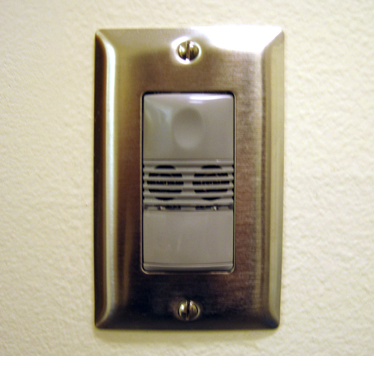
Harmonize
Minimization of conflicts and rules
Separate high stimulus, noisy areas.
Locating communal activity spaces away from low-stimulus, quiet areas – such as bedrooms – enables activities to take place without disturbing others.
Locating communal activity spaces away from low-stimulus, quiet areas – such as bedrooms – enables activities to take place without disturbing others.
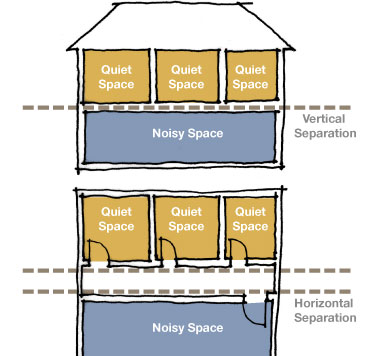
![In Our Apartment It's Easy “In [the old communal shelter] my daughter and I just read in the bunk bed. She’d read a page and then she’d hand the book down for me to read a page….And it was okay, but you could hear everyone else milling around, playing music, TV and this and that, so you know, it was a little more distracting….In our apartment, its completely easy because we can just sit together on the couch and read to each other…” -resident of YWCA Pierce County](https://www.buildingdignity.wscadv.org/wp-content/uploads/2012/02/In-Our-Apartment-Its-Easy.bmp)
Ample restrooms reduce stress and increase dignity.
A private bathroom or a generous number of shared bathrooms supports morning and evening parenting routines, including getting children ready for school and settled at bedtime.
Ideally, each family would have their own bathroom. When this is not possible, as in a converted single family house shelter, prioritizing additional bathroom facilities in a renovation will increase quality of life.
Whenever possible, make sure more than one bathroom is accessible; more than one resident may be living with an injury or disability at any one time. Refer to the Americans with Disabilities Act (ADA) Standards for Accessible Design, current edition, for recommendations.
A private bathroom or a generous number of shared bathrooms supports morning and evening parenting routines, including getting children ready for school and settled at bedtime.
Ideally, each family would have their own bathroom. When this is not possible, as in a converted single family house shelter, prioritizing additional bathroom facilities in a renovation will increase quality of life.
Whenever possible, make sure more than one bathroom is accessible; more than one resident may be living with an injury or disability at any one time. Refer to the Americans with Disabilities Act (ADA) Standards for Accessible Design, current edition, for recommendations.
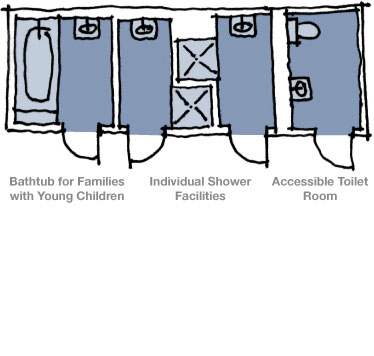

Bathroom privacy can be very important for people overcoming trauma. Survivors with histories of sexual assault, being denied privacy, disabilities or injuries all appreciate having a private bathroom.
In focus groups, residents indicated that sharing bathrooms with strangers or non family members is a particular area of difficulty. Tensions over bathroom cleanliness are unavoidable when bathrooms are shared.
Separate different bathroom functions.
By separating the toilet room from the sink or the shower from the rest of the bathroom, multiple people can get ready for the day at the same time.
By separating the toilet room from the sink or the shower from the rest of the bathroom, multiple people can get ready for the day at the same time.
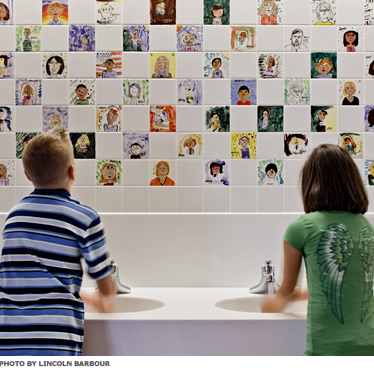
Changing stations in or near bathrooms helps parents.
Diaper disposal at each changing table/station (Diaper Genie, etc.) eases daily routines.
Diaper disposal at each changing table/station (Diaper Genie, etc.) eases daily routines.
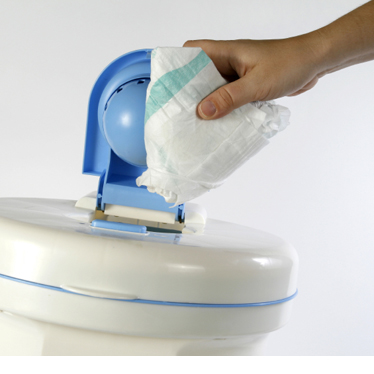
Control acoustics (not people).
In a shared environment, minimizing noise provides privacy and a sense of peace. Loud spaces make it difficult for residents to concentrate, families to engage in quiet activities, children to focus on homework, and residents to sleep.
Well-sealed, floor-to-structure walls help prevent noise transfer between rooms and enhance privacy. Ceiling and/or wall acoustic panels help reduce noise within a room.
Solid core doors and door hardware, such as silencers, gasketing, and weatherstripping, can all help control noise transfer.
Acoustic sound machines or white noise machines are another effective tool to assist people with blocking out external noises. These portable devices can be turned on and moved around as required.
In a shared environment, minimizing noise provides privacy and a sense of peace. Loud spaces make it difficult for residents to concentrate, families to engage in quiet activities, children to focus on homework, and residents to sleep.
Well-sealed, floor-to-structure walls help prevent noise transfer between rooms and enhance privacy. Ceiling and/or wall acoustic panels help reduce noise within a room.
Solid core doors and door hardware, such as silencers, gasketing, and weatherstripping, can all help control noise transfer.
Acoustic sound machines or white noise machines are another effective tool to assist people with blocking out external noises. These portable devices can be turned on and moved around as required.
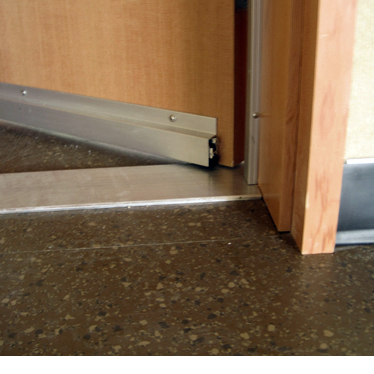

Solid core wood doors and an automatic door bottom are ways to control noise transfer and maintain privacy.
Generous storage keeps communal spaces clean and comfortable.
Storage of communal items allow access to resources such as art materials, books, videos, and so on.
In communal living shelters individualized lockable storage helps residents safeguard their valuables and reduces conflicts over missing items.
Programs that use these strategies report less staff time spent on mediating conflicts, which means more time available for DV advocacy.
Storage of communal items allow access to resources such as art materials, books, videos, and so on.
In communal living shelters individualized lockable storage helps residents safeguard their valuables and reduces conflicts over missing items.
Programs that use these strategies report less staff time spent on mediating conflicts, which means more time available for DV advocacy.
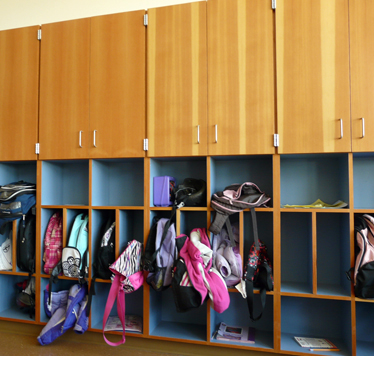

Avoid locking away resources meant for residents’ use, such as food and clothing storage, play spaces, craft supplies, and extra linens. Access to resources without staff assistance affirms survivor’s dignity and privacy while encouraging a sense of home.
For staff related benefits, see
Staff Space: Empower
Durable, easy to clean, finishes can be warm and inviting without feeling institutional.
Finishes typically used in single family homes are not durable enough for the heavy use domestic violence shelters experience.
Durable easy to clean finishes include:
Finishes typically used in single family homes are not durable enough for the heavy use domestic violence shelters experience.
Durable easy to clean finishes include:
- Solid wood as opposed to veneers on cabinets and furniture
- Hard surface flooring (i.e. examples)
- Washable, easily replaceable area rugs as opposed to carpet
- Porcelain toilets and sinks as opposed to stainless steel, etc
- One piece fiberglass tubs and showers minimize maintenance
- Commercial grade furniture and cabinetry
- Stainless steel or engineered stone (i.e. Caesarstone) counters
- Carpet tiles versus wall to wall (if carpet is required) to ease replacement of damaged or stained sections (ie, FLOR or Shaw carpet tiles)
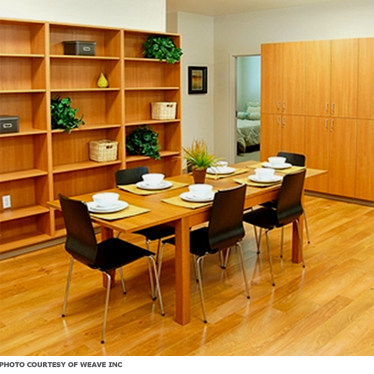
Easily accessible child proof cabinets to store cleaning supplies on each floor and in each bathroom make cleaning easier.
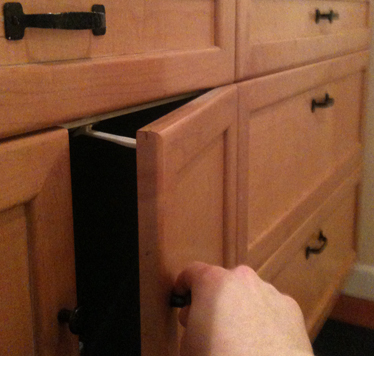
Occupancy (motion) sensors make sustainability easier.
They can be used in hallways, laundry rooms, and bathrooms to control electric lighting and save on energy costs. If no motion is detected, it is assumed that the space is empty, and thus does not need to be lit. Turning off the lights in such circumstances can save substantial amounts of energy.
They can be used in hallways, laundry rooms, and bathrooms to control electric lighting and save on energy costs. If no motion is detected, it is assumed that the space is empty, and thus does not need to be lit. Turning off the lights in such circumstances can save substantial amounts of energy.
